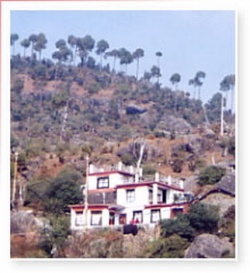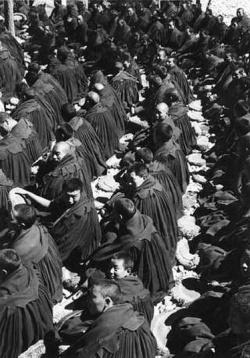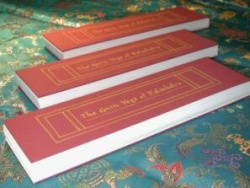A Review of Monasteries in Qamdo
When Zelho, Director of the Qamdo Communications Bureau, was informed of our intention to visit Monasteries in Qamdo, he immediately arranged for us to have the use of a Prince Desert V-8, the best motor vehicle in the area. We were also lucky enough to have Benba Cering, attached to the Qamdo Prefectural United Front Work Department, as our guide. "The Bon Religion has a long history in the Qamdo area, and the Sagya Sect and the Gagyu Sect were the first sects of Tibetan Buddhism to flourish in the area," explained Benba Cering. "The Garma Monastery was the first Monastery of the Gagyu Sect. During the Ming Dynasty and thereafter, the Gelug Sect built the Qambaling Monastery here. "Before the Democratic Reform in 1959, there were 322 Monasteries of the Gelug Sect, 212 of the Nyingma Sect, 117 of the Garma Gagyu Sect, and 52 of the Sagya Sect, plus one Catholic church.
QAMBALING Monastery. We reached Qambaling Monastery on the afternoon of June 27. Also called the Qamdo Gedain Qambaling Monastery, it is the first Monastery in the Kham area after the Gelug Sect built the three Monasteries in Lhasa. It is sited where the Ongqu and Zhaqu Rivers meet, and is the first of its kind built in the Kham area. It is also the oldest Monastery of the Gelug Sect in areas inhabited by Tibetans except Lhasa. Master Zongkapa, founder of the Gelug sect, stayed in Qamdo when he went to study Sutras In Tibet at the age of 16. Overwhelmed by the attractive environment, he predicted that it was most suitable site for construction of Monasteries. When Xangsheng Xirab Sangbo, son of the chief of a 1,000-Household Office in Riwoqe, finished his studies in the Sera Monastery, he had the Qambaling Monastery built in Qamdo according to the will of Gyiachaogyi, the first Disciple of Zongkapa, in 1437. And he became the Monastery's first abbot. Eminent Monks from other Monasteries were invited to serve as the Monastery's 2nd-13th abbots. When the 3rd Parbalha became the 14th abbot of the Qambaling Monastery, he set a precedent whereby succeeding generations of the Living Buddha Parbalha became the chief abbot of the Monastery, and leader of its five major Living Buddhas. The 6th, 7th, 8th and 9th Living Buddha Parbalha all received honorific titles from the Qing Dynasty emperors. Qambaling Monastery grew into the largest Monastery of the Gelug Sect. Before Liberation, it was the religious center of the Qamdo area, and also its political center. Qambaling Monastery is composed of the Grand Sutra Hall surrounded by the Tara Hall, Sutra Debating Courty, Gedorlha Palace, Gardain Phodrang, nine Zhacang Sutra study schools, the Sutra Printing Hall, and eight dagobas. It has a collection of tens of millions of metallic, wooden and clay Statues of Buddha, Tangka painting scrolls, religious objects, and Buddhist classics. During its heyday, the Monastery supervised 130-odd sub-Monasteries located in Qamdo and other parts of Tibet. Since 1978, the year when the reform and opening program was launched, the Central Government has allocated some 20 million Yuan to repair Monasteries. Now, the number of Monks in Monasteries has risen to 851, including 26 who have won the highest Buddhist academic degree of Geshi. The Monastery now owns 33.3 hectares of land on which a Qamdo Cultural Tour Zone and a hotel are being built. It also owns a timber processing factory, a zanba processing factory, and seven beasts-driven carts. Its annual income reached more than 2 million Yuan, enough for it to hold religious Activities, repair buildings, and improve the Life of the Monks.
RIWOQE Monastery. Tibetan Buddhists traditionally visit the Jokhang Monastery first and the Chagyima Hall second. In Tibetan Riwoqe means high mountains. When we got to Riwoqe Monastery, we were pleased to see emerald mountains shaded by towering Trees. We reached the place at 11 on the morning of June 28. Located some 30 km from the county seat, it originally belonged to the Darlung Gagyu Sect. Legend has it that the Rabxi family lived here, engaged mainly in farming. In 1277, while Rabxi was tilling the land, he met an old Monk sitting by the field dyke. He was the son of the 4th Prince of Dharma of the Darlung Monastery, and told Rabxi he intended to have a Monastery built here. Rabxi assisted the Monk in the construction, and the Monk, named Sanggyiwen, served as its first abbot. In 1326, Abbot Wogyain Gongbo had the Chagyima Hall built. As the Chagyima Hall was unique in shape and very elegant, it became the Symbol of the Darlung Gagyu Sect. As the Monastery and the hall were located in Riwoqe, they were eventually referred to as the Riwoqe Monastery. There have been 23 generations of the abbots. The Reincarnation system was introduced for the 12th and later generations. Historically, there are the Living Buddha Gyizong, Pongchow and Xazong systems. Riwoqe was historically one of the largest Monasteries in the Kham area. Under it were 58 subordinate Monasteries located in Qamdo and other areas inhabited by Tibetans in Qinghai, Sichuan and Yunnan provinces. During its heyday, it had a Monk population of 2,500. In the mid-20th century, there were close to 2,000 Monks. The Central Government of various dynasties attached high importance to Riwoqe Monastery. During the Yuan Dynasty, when Empress Marka went to worship in the Tibetan area, she visited Riwoqe Monastery and left behind half of her belongings as alms. During the ensuing Ming Dynasty, Zhu Yuanzhang, the founding emperor appointed 3rd Abbot Gywa Cangyain as "Grand State Tutor". During the Qing Dynasty, abbots of the Monastery also received honorific titles from the emperor. The 30-meter high Chagyima Hall has three stories. The first story, rising 13.5 meters, has outer walls painted with three colors in the Form of colorful stripes each one-meter apart. Inside the hall are 64 pillars each rising 15 meters, with four reaching the top of the third story. It holds elegantly carved Statues of Buddha and Tangka painting scrolls. Historically, there were some 40,000 Statues of Buddha enshrined here. The second story, rising nine meters, has outer walls painted in red. The inner walls are painted with frescos telling stories of eminent Monks of the Gagyu Sect showing the birth and development of the sect. The third story, rising five meters, has outer walls painted in white. Inside the hall are treasures unique to the Monastery, including the gold statue of Sakyamuni that Sanggyiwen brought here from Lhasa. Legend has it that it contains Relics of the Buddha, including one piece of his bone. Other treasures include dozens of Tangka paintings dated back to the Yuan, Ming and Qing dynasties; Sutra Books written in gold or silver powder; saddle and sword, which are believed to belong to King Gesar.
ZEZHOL Monastery. The Tibetans call themselves Bod-pa, which means "people living in the Bod region." It is believed that the Name Bod is derived from the Name Bon, an animist Religion followed by many of the Tibetans prior to the advent of Buddhism. Worshippers of the Bon Religion held that everything in the World has a soul. Professional believers held various kinds of sacrificial Activities. In the 7th century when Buddhism spread into Tubo, it collided with the Bon Religion in both theory and organization. The Bon Religion, formerly very primitive, finally grew in terms of theory and organization. The Garma Monastery is 120 km away from Qamdo, standing on the upper reaches of the Zhaqu River. Going to the Monastery one has to pass through a place called Let. Legend has it that on the slope of Let there was a Monastery of the Bon Religion that housed a Bon master, who ordered his servant Monks to guard the road and let no outsider pass. One day, a hungry dog came and the servant Monk let it pass, as it was an animal. The master panicked on hearing the news and left the Monastery thereafter. The hungry dog was an incarnation of Master Garmaba Duisum Qenba, who built the Garma Monastery here. This signified the creation of the Garma Gagyu Sect of Tibetan Buddhism in this part of the World. Statistics show in 1991 there were 55 Monasteries in Qamdo Prefecture, including 31 in Dengqen, nine in Zogan, six in Gyamda, five in Lholung, three in Baxoi and one in Qamdo Town. In Qamdo Prefecture today, there are still people who worship the Bon Religion. It has 94 Monasteries, Zezhol Monastery being the largest. In fact, the Zezhol Monastery is also the largest of its kind In Tibet in terms of size and number of Bon followers. It is kept intact. Located in Joren Township 45 km from the county seat, it is today known for its perfect system in the study of open and secret schools. It has 110 Monks.


